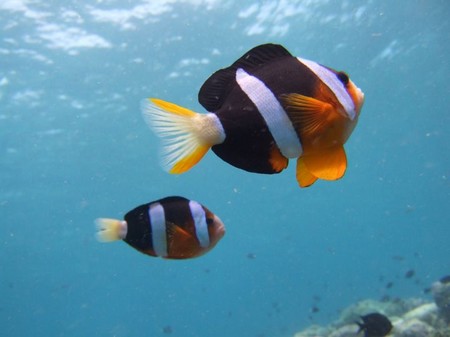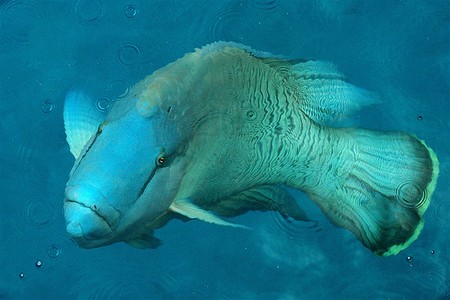With their heavy body armour, the earliest fish were slow swimmers and lived close to the bottom of rivers or seas. As they evolved, however, they became more active, and so needed more oxygen – just as a human might gasp for breath after a sprint. Increased activity also made buoyancy control more important so that the fish could adjust their depth in the water.
Just as we depend on lungs to let us breathe in oxygen from air, most fish have gills to take in oxygen dissolved in water. In cartilaginous fish, the outside of the gills take the form of slits on either side behind the head, whereas in bony fish, they are covered by a flap called the operculum.
How the gills work
Fish take in water through the mouth. The water then passes over the gills where oxygen is absorbed into the bloodstream. At the same time, carbon dioxide from the body diffuses into the water. In cartilaginous fish, this deoxygenated water is then expelled from the body via the gill slits; in bony fish, the process is more complicated. While water is taken in through the mouth, the operculum and its membrane seal off the gills internally. As the water passes through the gill network, the operculum is raised to let the water out.
Different breathing techniques
The evolution of fish-breathing apparatus branched in diverse directions. Perhaps most remarkable are the lungfish (family Ceratodiformes), which have changed relatively little in the 400 million years since they first appeared. The African and South American species inhabit regions where stretches of water commonly dry out during seasonal droughts. When this happens, these fish survive by breathing atmospheric air directly, rather than relying on their gills. It is inhaled through a pair of nostrils located on either side of the mouth, then passes through the mouth into the lungs.
These extraordinary fish are also able to absorb oxygen through their skin, in a similar way to amphibians. Both African and South American lungfish will survive periods out of water, unlike their Australian relative, which has only one lung. As the water level falls, they burrow down into the mud. The African species actually secrete a cocoon of protective mucus around themselves.
When breeding, male lungfish develop filaments on their pectoral fins, which enable them to absorb oxygen from the water so that they can remain with the eggs, rather than having to breathe atmospheric air. Once the young lungfish emerge from the eggs, they have external gills, rather like newt tadpoles, for up to six months after hatching.
Some fish have to obtain oxygen from stagnant water that is low in oxygen and so have evolved other means of respiration to compensate when their gills are unable to function effectively. Many catfish, such as the armoured catfish (Hoplosternum species), have accessory respiratory organs. The fish come to the surface and gulp down atmospheric air, from which oxygen is then extracted in the hind gut of the intestinal tract. Snakeheads (Chnnna species) have an air-sac bladder near the gills, which enables them to absorb atmospheric air.
The labyrinth organ
Some fish have a means of taking in additional oxygen via the labyrinth organ, a maze-like structure that is located just behind the gills. It is present in gouramis and most other anabantoid fish, which are commonly found in stretches of water that may have a low oxygen content. Oxygen from the air can be absorbed directly into the bloodstream from the labyrinth organ, and some members of this family, such as the spotted climbing perch (Ctenopoma acutirostre) even rely on this source of oxygen to keep them alive out of the water. These particular fish may sometimes be encountered moving across land, propelling themselves with their powerful pectoral fins.
Controlling buoyancy
As fish started to move off the bottom and occupy other levels in the water, they began to evolve ways of altering their degree of buoyancy so they cou4d-certtroI their depth. Early osteichthyans had a pair of air sacs on the underside of the body which enabled them to adjust their level in the water by reducing or increasing the volume of air trapped here.

The swim-bladder
Over time, these air sacs fused in ray-finned fish, to create an organ known as a swim-bladder. In teleost fish, it is located in the upper body, connecting to the intestine. The importance of the swim-bladder becomes especially apparent when it stops functioning normally, impeding the fish’s swimming ability and making it hang at an abnormal angle in the water. In some fish, the swim-bladder has become a totally separate organ, functioning independently. Special gas glands at the front of the swim-bladder enable carbon dioxide from the blood to enter it, increasing the gaseous pressure so the fish rises in the water. Conversely, the pressure may be reduced by gas being absorbed back into the blood towards the rear of the swim-bladder, like adding or releasing air from a hot air balloon to make it go up or down.
By helping to keep the fish afloat, the swim-bladder serves to reduce the fish’s energy requirement. Cartilaginous fish such as sharks which lack a swim-bladder are forced to remain close to the bottom or must be powerful swimmers, in order to maintain their position in the water without sinking.
